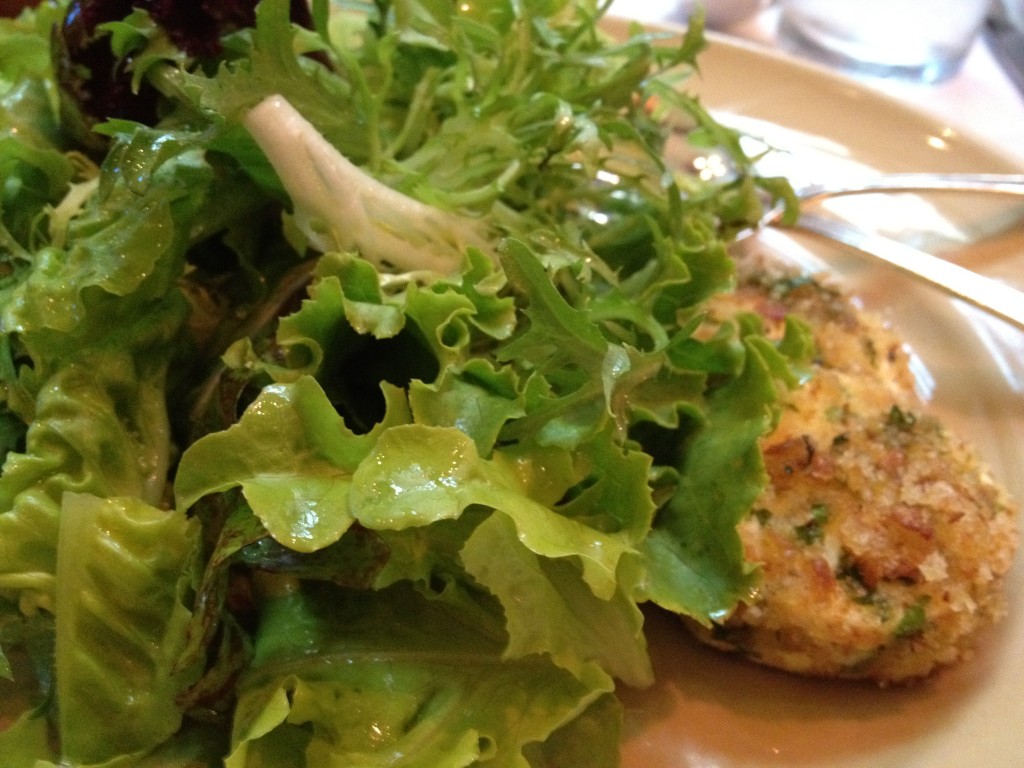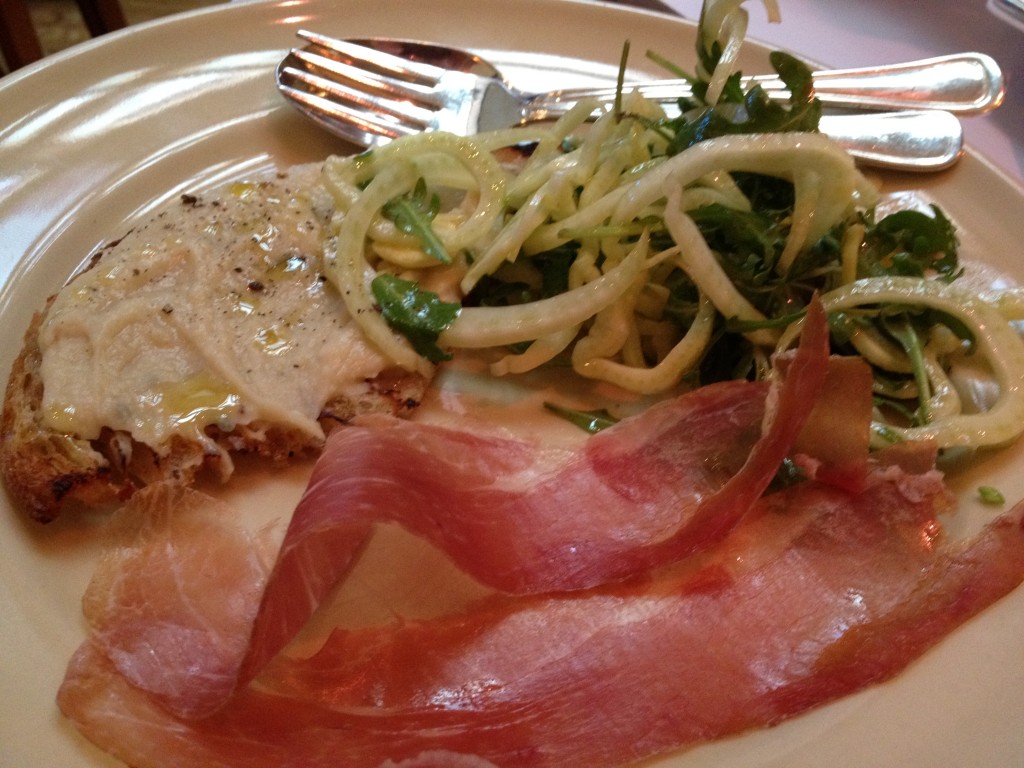Every restaurant and chef has a story. But rarely does a restaurant have a more than 40-year history, a legendary owner, and a book to chronicle it all. This makes my visit to Alice Water’s Chez Panisse in Berkeley, California an experience that is about far more than the food.
I am heading to Berkeley for a meeting. Oddly, it’s little more than a week before my trip and I am not yet focused on the restaurants. A colleague asks if I will be dining at Chez Panisse. I stare blankly until she mentions the name Alice Waters. My eyes widen with excitement. A few hours later I make a reservation for Chez Panisse Cafe, and begin to study its history. My research goes into full force when I board the plane with the book “Alice Waters and Chez Panisse” by Thomas McNamee.
Here’s a brief bio on Alice Waters from Wikipedia:
Alice Louise Waters is a US chef, restaurateur, activist, and author. She is the owner of Chez Panisse, a Berkeley, California restaurant famous for its organic, locally-grown ingredients and for pioneering California cuisine. Waters opened the restaurant in 1971. It has consistently ranked among the World’s 50 Best Restaurants. Waters has been cited as one of the most influential figures in food in the past 50 years, and has been called the mother of American food. She is currently one of the most visible supporters of the organic food movement, and has been a proponent of organics for over 40 years.
I find the story of Chez Panisse enthralling. It is about the passion consistently exhibited by Alice Waters…. for food, for people, and for principles. Can the restaurant live up to my expectations?
I’ve chosen to dine in the upstairs café for a variety of reasons, including the fact that it allows for more choices compared to the prix fixe restaurant downstairs. The one thing I notice immediately is that the tables upstairs are very close together. I am about a third of the way through the book, and so I know that initially this is something that Alice resisted. She was far more concerned with diners comfort than profitability. Coming here with a little knowledge could be dangerous. It is definitely going to affect my experience, one way or another.
The server is a little staid. I want to know what he can tell me about the current Chez Panisse compared to the early days, but I am inhibited by the close proximity of our neighbors. I do manage to tell him that I’m reading “Alice Waters and Chez Panisse,” and hope that he will help my colleague and I select menu options that represent the best of the café. He brightens a bit, and encourages us to share dishes so that we can sample more of the offerings. I ask if he’s read the book and he replies that he prefers the oral history that unfolds to him a little at a time.
A delicious crusty bread is served and I know without asking that it is from Acme Bread Company. The bread is sold in San Francisco’s Ferry Building, and I’ve had the good fortune to enjoy it on previous trips.
Our first starter is baked Andante Dairy goat cheese with garden lettuces, which we are told is always on the menu and is described as “the quintessential Chez Panisse Café dish.” I don’t realize until I continue reading the book on the trip home that this represents the very first salad with warm goat cheese, created in 1980. From “Alice Waters and Chez Panisse”:
Alice’s idea of warm goat cheese in a salad was apparently unprecedented. “There may have been baked goat cheese in France,” she says, “but I don’t think anybody had ever combined it with a salad.”
The goat cheese is marinated with olive oil and herbs, lightly coated with bread crumbs, and baked. The salad consists of greens with just a touch of vinaigrette. My first bites of food are exactly what I expect. Simple ingredients that gain flavor from their absolute purity and freshness. I have been a long-time aficionado of warm goat cheese in salad. Now I know who I can thank for it.
Our second starter is cannellini bean crostini with rosemary, fennel, and prosciutto. I delight in alternating bites of the crunchy, salty crostini with the bright and tangy fennel salad. My mind wanders back to the book. One of the original goals of the café is to utilize leftovers from the downstairs restaurant. I wonder how many of these ingredients were featured in the previous evening’s tasting menu.
A pasta dish has been served at several tables around us, and it looks particularly appealing. As we are pondering our choices, the server suggests that we split half a portion of the pasta entree as a middle course between our appetizers and entrees. The idea brings a huge smile to my face, not only because it means I will get to experience another dish. I appreciate a restaurant that allows for flexibility. This is demonstrated again when we are asked if we want more wine. I’m enjoying the Chez Panisse Zinfandel from Green & Red Vineyards in Napa Valley. I recognize the vineyard as the purveyor of the house Zinfandel since the mid-to- late 1970’s. The server, sensing my reluctance to order more wine, suggests I order half a glass. Once again, it is the perfect solution.
The house-made noodles with porcini mushroom ragu and an herb gremolata deliver earthy flavors. The noodles are chewy and the mushrooms have a slightly smoky quality, with a citrus finish. The half portion gives us each an enjoyably adequate taste. It’s a great dish, but I am glad I haven’t chosen it as my entree. I am ready to sink my teeth into some locally sourced meat.
We split two entrees. The first is Grilled Elliott Ranch lamb leg with potato and greens gratin, little turnips, and tapenade. The lamb is tender and juicy, but it’s the tapenade that gives the dish its real oomph. I relish every bite of my half portion.
We continue with Wolfe Ranch quail roasted in the wood oven with polenta, cranberry beans, summer squash, tomato confit, and sage. I am eager to sample something prepared in the wood oven, as it is has been an essential component of the café since the beginning. This ends up being a wise decision, as the rustic dish brings forth a variety of flavors. In addition to the well-prepared quail, I am a fan of the corn polenta. I’m happy to secure a few extra bites from my dining companion, since she doesn’t like corn.
Dessert? But of course. Although at this point we don’t want anything too heavy. We share apricot sherbet with roasted cherries and langue de chat, which is a butter cookie. The tart sherbet provides an ideal ending to a meal filled with bright, fresh, simple, and clean flavors. My enjoyment of Chez Panisse Café is not only a result of high quality food, but the fact that I’ve gained an understanding of what has inspired the ingredients and preparation.
I ask what kind of presence Alice Waters has at Chez Panisse these forty years later. It is gratifying to know that when she is home, she is at the restaurant daily. I am sure that her continued work as a champion of the Slow Food movement and as the creator of The Edible Schoolyard* keeps her quite busy.
As I continue to read “Alice Waters and Chez Panisse” my fascination and admiration grows. I am inspired by Waters dedication to a single cause that has literally changed the face of how America eats. I’m a little embarrassed when I think about my passion, which is primarily limited to eating. If nothing else, I’m hoping to change my own story by becoming more committed to buying locally grown food and supporting the increasing number of restaurants who are dedicated to doing the same.
Chez Panisse, 1517 Shattuck Avenue, Berkeley, California
*The Edible Schoolyard is nationally recognized for its efforts to integrate gardening, cooking, and sharing school lunch into the core academic curriculum. Alice established the Chez Panisse Foundation in 1996 to support the Schoolyard and encourage similar programs that use food traditions to teach, nurture, and empower young people. The success of The Edible Schoolyard led to the School Lunch Initiative, whose national agenda integrates a nutritious daily lunch and gardening experience into the academic curriculum of all public schools in the United States.











